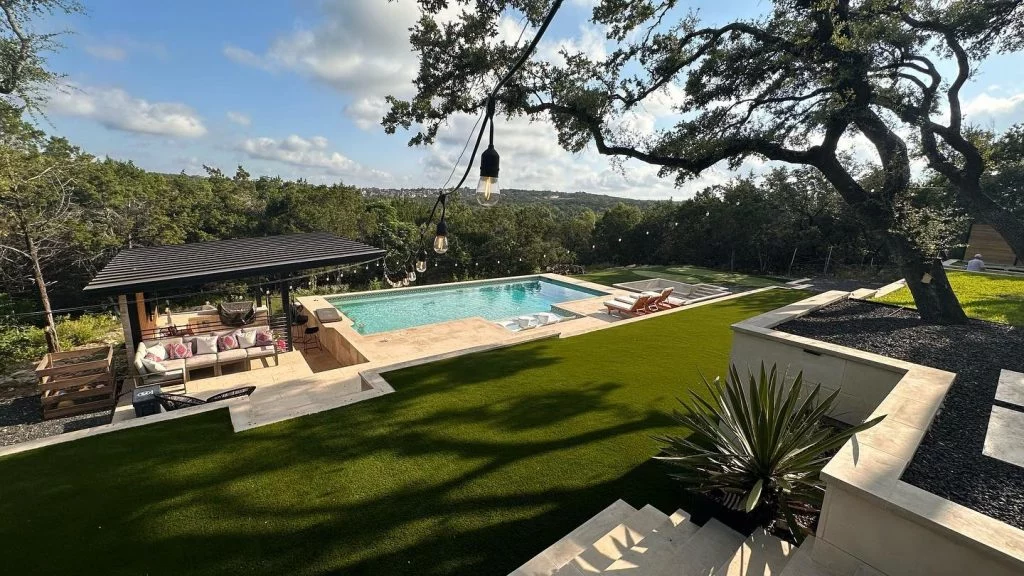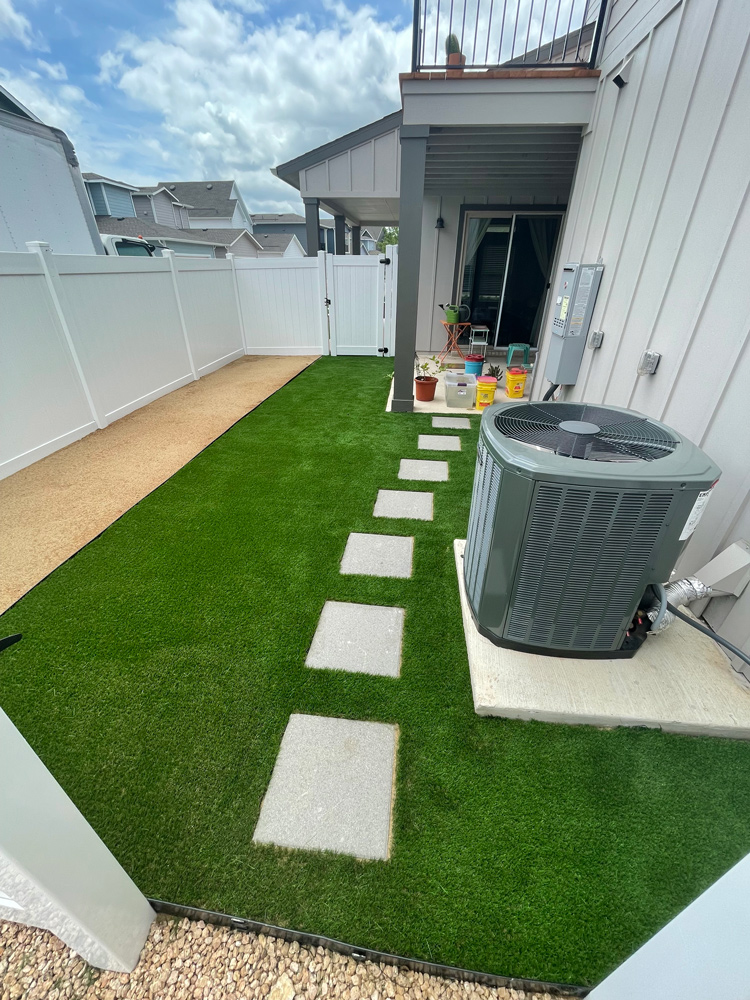When it comes to transforming your outdoor space, one of the biggest decisions you’ll face is this: grass vs artificial turf. Homeowners across Texas and the broader southern region are rethinking their lawns, looking for ways to cut down on maintenance, save on water bills, and still enjoy a lush, green yard year-round. Whether you’re upgrading the backyard, renovating around a pool, or managing a commercial property, the choice between artificial vs real grass can have long-term effects on your budget, lifestyle, and curb appeal.
At Lone Star Turf, we’ve walked hundreds of homeowners through this very decision. We understand the questions and the concerns: the upfront cost, the realism of turf, how it holds up to pets, and whether it’s really worth the switch. So we’re breaking it all down in a side-by-side comparison—honest, straightforward, and rooted in real experience.
Is Turf or Grass Cheaper in the Long Run?
Many homeowners feel the sting of sticker shock when they first learn how much artificial turf costs to install. Compared to real grass, which only runs a couple of bucks per square foot to lay down, turf can cost anywhere from $8 to $15 per square foot—but that’s only the beginning of the story. Once installed, artificial turf essentially pays for itself.
Real grass demands constant care—weekly mowing, regular watering, seasonal fertilizing, weed control, pest treatment, and often reseeding or patching bald spots. Over a decade, it’s common for homeowners to spend upwards of $15,000 just to keep natural grass looking decent. Turf, on the other hand, requires almost no ongoing expense, which means the higher upfront cost turns into long-term savings over time.
Which Requires Less Maintenance? Turf or Grass?
If you’re tired of pushing a mower in 100-degree heat or trying to troubleshoot yet another brown patch, turf might just be your best friend. One of the biggest lifestyle advantages in the artificial vs real grass debate is how much less work turf demands. Once installed, there’s no mowing, no watering, no fertilizing, and no muddy messes after rain.
Real grass, by contrast, is a high-maintenance partner—especially in the South. Grass growth surges in spring and summer, weeds thrive in humid climates, and watering restrictions in drought-prone areas like Texas can make it almost impossible to keep a natural lawn green without breaking the rules or the bank. If you’re managing a family, pets, or a busy schedule, the idea of a mud-free yard with minimal upkeep is a major draw.
How Realistic Does Artificial Turf Look and Feel?
Turf has evolved from what looked like green carpet a few decades ago to modern materials so realistic the neighbors will do a double-take. Modern turf mimics the color, density, and even the slight imperfections of natural grass. Our premium materials feature multi-toned blades, subtle thatch layers, and soft-touch fibers built for realism.
For front yards, backyard renovations, and high-end landscape projects, artificial turf offers the beauty of a well-manicured lawn without the brown patches or mower lines. Just green, all year long.
Is Artificial Turf Safe for Kids and Pets?
When comparing grass vs artificial turf for families with children or pets, safety and cleanliness matter just as much as looks. Artificial turf has a slight edge here—especially when you consider the chemical treatments needed to maintain real grass. Lawn fertilizers, herbicides, and pest control products can be harmful if tracked indoors or ingested by pets.
Artificial turf doesn’t need any of that. It stays green without harsh chemicals and includes options specifically engineered for pets and play areas. At Lone Star Turf, we install products with antimicrobial infill, excellent drainage, and padded backing for shock absorption. That means fewer scraped knees, less mud in the house, and no more holes dug up by overexcited pups. For households with kids, dogs, or both, turf delivers a worry-free, low-mess environment that’s always ready to play.

How Does Turf vs Real Grass Perform Around Pools and Play Areas?
Traditional grass and swimming pools don’t always mix. Real grass around a pool often turns into a soggy, slippery mess. Chlorine and foot traffic can kill patches of lawn, and it’s tough to keep the mud and grass out of the water and out of the house..
Artificial turf is the no-slip solution. It drains fast, stays dry on the surface, and never turns into mud—even after the biggest cannonballs. If your lawn doubles as a party zone, play space, or pool deck, turf is the year-round MVP.
What’s the Environmental Impact of Turf vs Grass?
This is where some folks get tripped up. Turf’s made from synthetic materials, so is it really better for the environment? In southern regions, the answer is often yes—especially when you look at water use, emissions, and chemical runoff over time.
Real grass can consume tens of thousands of gallons of water each year just to stay green. In a region where drought conditions are becoming the norm, that’s a big drain on local resources. Turf, by contrast, doesn’t need watering at all, except for the occasional rinse-off. It also eliminates the need for gas-powered mowers, weed killers, and fertilizers, all of which contribute to pollution and runoff.
And while turf isn’t biodegradable, many modern systems—including those installed by Lone Star Turf—can be partially recycled at the end of their lifespan. Combined with the long durability (10–15 years or more), it often nets out as a more sustainable choice—especially for larger or high-use areas.
How Does Each Handle Southern Weather?
Southern lawns have to endure blazing summers, torrential downpours, and the occasional ice storm. In the artificial vs real grass debate, durability is a key concern, and turf consistently comes out ahead.
Natural grass struggles in extreme weather. It browns in the heat, floods easily, and turns brittle or dormant in colder snaps. On the flip side, artificial turf stays resilient. With UV-resistant blades and a layered drainage system underneath, it holds its shape and color through every season.
While turf can heat up under direct sunlight, Lone Star Turf offers cooling infill technologies that significantly reduce surface temperatures. For shaded yards or partially covered areas, artificial turf remains comfortable. Turf doesn’t just survive the elements—it thrives in them.

Key Differences at a Glance: Artificial vs Real Grass
Here’s a quick summary to help you see how grass vs artificial turf stack up on the major points:
| Feature | Artificial Turf | Real Grass |
| Upfront Cost | Higher ($8–$15/sq ft) | Lower ($1–$2/sq ft) |
| Maintenance | Minimal (occasional rinse or fluff) | High (mowing, watering, treatments) |
| Lifespan | 10–15+ years | Seasonal/patchy, often reseeded annually |
| Realism | Highly realistic with modern turf | Naturally lush (when healthy) |
| Kid/Pet Friendly | Safe, padded, no chemicals | Chemical use, uneven surfaces |
| Pool/Play Performance | Drains fast, no mud, non-slip | Slippery, muddy, patchy |
| Environmental Impact | Low water use, no emissions | High water and chemical use |
| All-Season Performance | Green year-round | Dormant in cold, brown in drought |
Final Thoughts: Making the Right Call for Your Lawn
Every yard has its own personality—and so does every homeowner. Some folks love the smell of fresh-cut grass, while others are more interested in reclaiming their weekends. That’s why there’s no one-size-fits-all answer to the artificial vs real grass debate. But if you’re looking for a durable, low-maintenance, family-friendly solution that stands up to southern weather, artificial turf might just be the upgrade your lawn deserves.
At Lone Star Turf, we specialize in turning yards into clean, beautiful, usable spaces—whether you’re chasing more playtime, fewer muddy paw prints, or a better ROI for your landscape budget. With our reliable service, premium products, and transparent approach, we’ll help you make the best decision for your home, your family, and your future.
Ready to explore your turf options? Let’s talk about getting you set up with turf as strong as the south. Schedule a free yard assessment, and we’ll walk you through the possibilities—no pressure, just honest advice and a look at what your yard could be.
Want to learn more about artificial turf and see if it’s a good fit for your home or business? Check out our Ultimate Guide to Artificial Turf.
